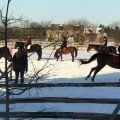I am sitting at a table made of walnut, on an oak chair of deep mature colour. As I rub my hands on the smooth careworn arms, I remember someone, a dear family member, who sat in this very chair for many years. I am surveying the landscape of my life, and the woods speak to me.
There is a cabin of strong hemlock beams that was given body through honeyed pine boards by my husband’s family. Hewn from the surrounding woods, they are a mirror of family life on this land. I look out at the shimmering sunlight through the reaching branches of the cedar grove to glimpses of a lake that lies just beyond. I am soothed by the warmth of the woods within, and the embrace of the woods without. Beautiful birdsong fills the air — the calls of the ubiquitous blue jay, the drumming of the grouse, the trills of purple finch.
As evening comes on, I hear the exquisite song of the hermit thrush and then the lowly whippoorwill calling its own name. I thrill to these sounds, deeply quiet, my ears alert as I listen to the wise stories of the eastern Ontario forest.
Suddenly, without warning, there is the roar of a boat circling in and out of the bay, where sits this cabin. I glance at my husband, questioningly, for this is not a common sound in this peaceful spot. We consider, wondering, but return to our books, feeling a little bit unsettled by the unusual activity. The forest has gone quiet, as if expressing its concern and uncertainty as well.
Then, roaring out of the sky, just as abruptly, there comes a helicopter, skimming the surface of the trees. The forest has gone completely silent, and I wonder if it is a search and rescue response. We both get up to go down to the lake to see what needs to be done. As the helicopter flies in and out of the bay, we watch as grey dust is dropped over areas of the forest. It is disconcerting, to say the least, as we realize that it is indeed an assault, but also a rescue mission. It is yet another story of this complicated and stressful year of plague and pestilence, this pandemic year. The trees are calling for help, but it is hard to know how to answer.
The helicopter is spraying the gypsy moth caterpillars that are decimating the forest canopy in eastern Ontario. Apparently, by the middle of summer 2021, 75 percent of the canopy will have been eaten by this invasive species. Oak, poplar, willow, apple, cherry, birch and pine will be particularly affected in the area between Perth, where our farm is located, and Peterborough and beyond.

They provide shelter, nutrition and travel ways for a variety of wildlife, people and livestock.
RIGHT: Ash trees that have succumbed to the emerald ash borer in a farm hedgerow, in eastern Ontario.
As I return from herding and gathering sheep every evening, I can hear the sounds of caterpillars munching through the leaves around me in the hedgerows. We are also under assault by the emerald ash borer, as it tunnels through all the ash trees on our farm. To say that the view of our landscape is threatening is an understatement. It is ugly, concerning, even depressing. The usual beauty of leafy hedgerows and lanes that our farm is well known for is being replaced by skeleton trees reaching desperately for nourishment in the soil and sky, to no avail.
The birds are still here, but they are very exposed to the elements. They seem to be surviving, but I wonder about the effect this summer will have on their numbers, as well as on the growth of the trees. Some trees seem less affected. The maple seems to have some resilience against the onslaught, for which I am grateful; as one of the stalwarts of our forest, it would be heartbreaking to see them go. For the trees decimated by the gypsy moth, they may also survive. If they aren’t sickened by disease or drought, they should be able to struggle back to life.
Some will be lost, though. The coniferous trees are the most at risk. The emerald ash borer will deal its devastating and fatal blow to most of the ash trees. As ubiquitous and resilient as ash trees have been in this part of the world, their days are numbered. Will some varieties develop resistance against this invasive insect, or are we seeing the end of this tree in our woods?

As I ponder these harsh realities, I look for comfort in the trees. The trees really do speak. They speak to one another, as research is showing. They also speak to their environment, their conditions, of their deep connections to us. We only have to listen. In this year particularly, I have often turned to the past for understanding and guidance. It is reassuring to look back at times that experienced great natural and social upheaval, and to realize that the basic underlying thrum of life continues, despite everything.
As a child, I grew up with a black-and-white picture of a big old elm tree. It hung, for years, on the wall of my grandparents’ house and then in my parents’ home. I had no idea why, but I felt that this tree was of great importance. It held meaning and deep respect. My grandparents and great-grandparents farmed just outside of Stratford, Ontario. Theirs was a beautiful, productive farm, but my grandfather came back from the war with shell shock (PTSD). My grandmother held that farm together for the whole family at a time when women were not supposed to be farmers.
There was an elm tree at the front of their farm that was a spectacular example of the species, a protecting umbrella that stood high above the farming landscape. My grandmother loved that tree. She used it as a straight guide, a way to plough, plant, and feel hope as she worked up and down those fields. At a time when women weren’t recognized as farmers or allowed to own farmland, she did the hard work for her family.
There was huge pressure to keep this legacy afloat, despite the pressure from illness, finances and world events. The tree was her beacon. When the township wanted to build an updated road across the front of the farm, my grandmother and some neighbours fought to protect it. Digging into the local lore of the community, they were told that the tree was growing on an Indigenous site for gathering and ceremony.
During early settlement years, this tree was again used as a gathering place, a place of guidance. My grandparents’ community argued that it was important to respect this tree. When the road was built, the township created a curve around the tree to save it.
Eventually, Dutch elm disease claimed this magnificent specimen, as with most other mature elms in Ontario. The family wanted to commemorate this beautiful farm, so they placed a cairn exactly where the tree used to grow. The tree’s spirit lives on — in the memories of people, the farm, the township and within
me — as I glance at this simple picture of a big old elm tree. This picture now graces the walls of my farmhouse, several generations later.

When we moved to our current farm about 20 years ago, one of the first things that caught my eye and made me fall in love with this place was the lone, lofty umbrella of a mature elm tree. It sat on a rise, right in the middle of our fields, as a beacon. I loved this elm tree. It was a symbol of strength and resilience while I spent hours and hours in the tractor, working the fields. I felt a kinship of continuity with the people who had worked this land when the tree was younger. It also gave me a visual aid to help me with my planting lines.
About 6 years ago, I noticed that one branch had stopped producing leaves. Then, the next year, there were more dead branches. The following year, the tree didn’t produce leaves. It was dead, succumbing to the horrible Dutch elm disease that it had miraculously evaded for so long.
Those few years, as it was dying, were tough years for us on the farm. It felt like a symbol of our downturn. We didn’t plant around that tree for those years. I always felt like I had abandoned it. The tree had no one to
appreciate it as the fields were left, untended, to grow weeds until we could afford to plant again. Even my son, who had grown up with that tree always being there, commented on the tremendous loss we all felt, after coming home from university during the summer it died.

Now we are back to planting and cultivating the fields around the remains of the elm tree. It still reaches for the sky with some branches, but the umbrella is gone. We watch it gradually return to the earth as branch by branch breaks off, returning to the soil. From soil other things will grow. It does irk one to rail against these devastating diseases that can sweep through our tree canopies. Could we have done more in the past? Should we do more in this current challenge?
Ultimately, we do what we can, then we have to accept and move on. The farm continues. Life continues. The thrum of its steady beat will get us through whatever challenge we face — if we tune in and listen.
In memory of Roberta Loten










